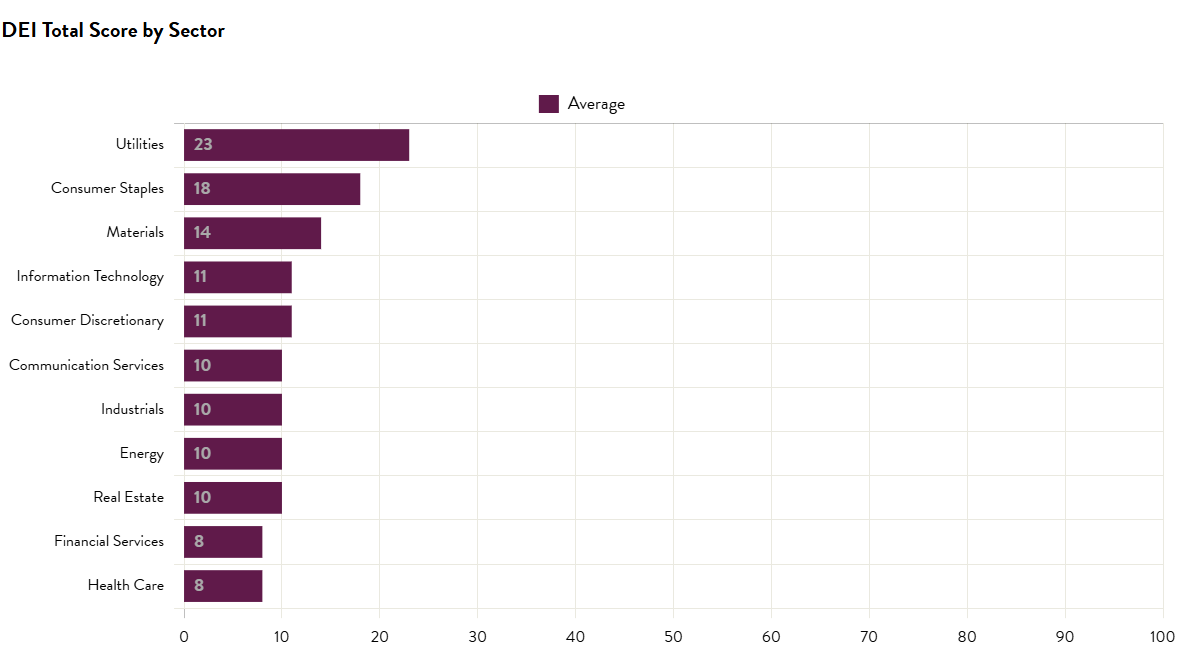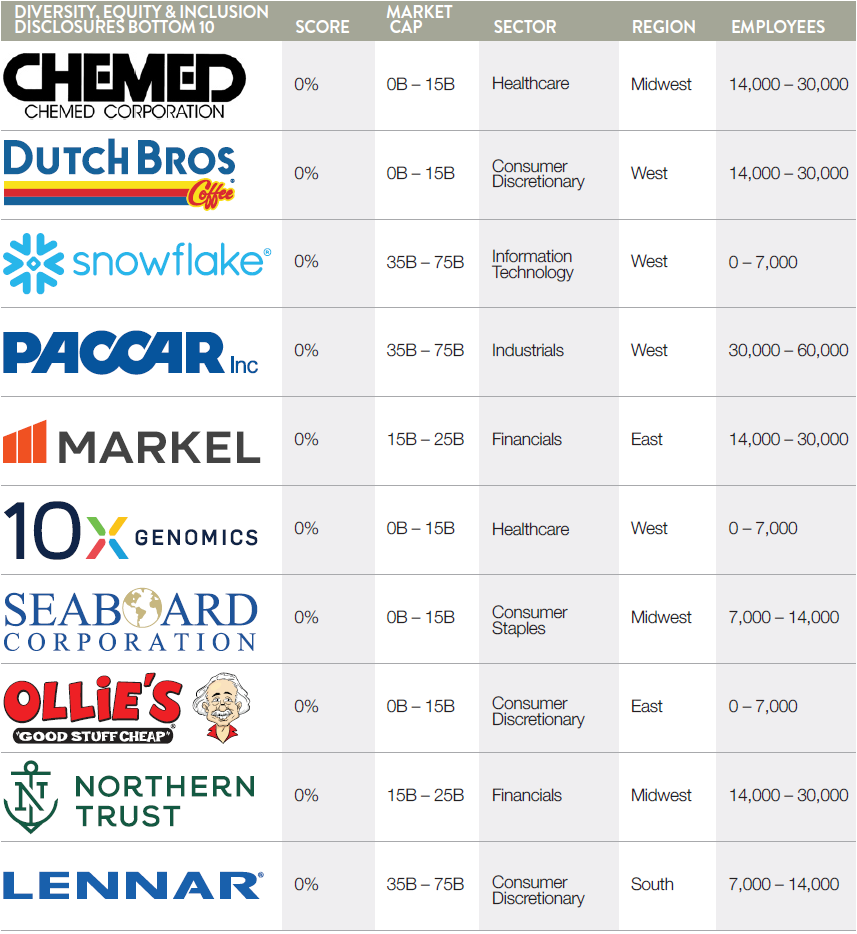Workplace Equity Report
PROMOTING DIVERSITY, EQUITY, AND INCLUSION THROUGH EDUCATIONAL SCORECARDS
As You Sow’s shareholder engagements related to the effective management of staff as a resource are informed by the data within the Workplace Equity Disclosure Scorecard. Companies are asked to release promotion, hiring/recruitment, and retention/turnover rates for employees, as well as two, or more, years of EEO-1 forms.
The release of the data is important from a transparency perspective and signals a company’s dedication to being able to source top talent, regardless of political headwinds. From a communications perspective we also recommend that companies place the data within a tailored narrative context specific to their organization, as to add additional details behind the numbers. The workplace equity data visualization tool tracks both released data and data that companies have committed to release.
Data related to workforce demographics helps investors, employees, and other external stakeholders understand if significant variances exist between a workforce composition that would reflect a meritocratic workplace versus one that may contain bias and discrimination which would diminish the effectiveness of the workforce.
BENCHMARKING METHODOLOGY, SCORING, AND KEY PERFORMANCE INDICATORS
As You Sow, in collaboration with the consultancy Whistle Stop Capital, has examined the websites and sustainability reports for each company in the Large-Cap 3000 to determine their current levels of transparency. Corporate disclosures of the aforementioned data contributed to companies’ scores, all of which were identified on a binary yes/no. That is, if a company releases the data set identified within the last five years, it receives all of the possible points for that set. The weighting of each data set is a reflection of how important the information is from a transparency perspective, relative to an investors’ ability to understand the effectiveness of a corporate employee inclusion program.
Our researchers visit corporate websites, looking through company reporting, blogs, sustainability/corporate responsibility/ annual reports, public SEC filings, and career pages as well as the companies’ social media sites. It is possible that they missed some reporting, or that the company has shifted its reporting since our review. To inform us of corporate reporting not captured here, please send a note to [email protected].
Our findings are presented on As You Sow’s website using a data visualization tool that enables dynamic analysis and sorting. The data is updated each quarter, with a major update annually.
LEADERS: TOP 10
LAGGARDS: BOTTOM 10
QUARTERLY KEY FINDINGS
Nearly 90% of the S&P 100 companies release, or have committed to release, their consolidated EEO-1 forms, a good first step for sharing workplace composition. In August 2020, when this benchmarking project began, only 20% of the S&P 100 did so.
18% of Large-Cap 3000 companies release or have committed to release their EEO-1 report, whereas almost half (45%) of Large-Cap 1000 companies do.
Nearly two-thirds (64%) of the Large-Cap 3000 companies release gender/racial demographic data on their workforce in some form, whereas 89% of Large-Cap 1000 companies do.
Within the Large-Cap 3000 constituent companies, the Financials sector has the most companies releasing their EEO-1 forms.
Within the Large-Cap 3000 constituent companies, the Financial Services sector has the most companies releasing promotion rate data and hiring rate data by gender. The Industrials sector has the most companies releasing retention rate data by gender.
Within the Large-Cap 3000 constituent companies, the Consumer Staples sector has the most companies releasing promotion rate data by race.
Within the Large-Cap 3000 constituent companies, the Healthcare and Information Technology sectors have the most companies releasing hiring rate data by race.
Within the Large-Cap 3000 constituent companies, the Financial Services sector has the most companies releasing retention rate data by race.
Of the inclusion factors, hiring rates are the most reported on, while promotion rates are the least.
Companies were most likely to release hiring rates of their Black and female employees. They were least likely to share data related to their Native American and Pacific Islander employees.
Disclosure rates of recruitment, retention, and promotion data by race and ethnicity is still catching up to gender data, likely a reflection of the #metoo movement gaining traction in 2017, while the protests in the aftermath of George Floyd’s murder began in late May, 2020, far more recently.
Companies that have made future, time-bound commitments to release at least two of the three inclusion factors are: Albertsons, Bank of America, Bank of New York Mellon, Baxter International, Biogen, Charter Communications, The Walt Disney Co., eBay, Electronic Arts, Estee Lauder, Ford Motor, General Dynamics, NCR Voyix, Philip Morris International, Raytheon Technologies, Simon Property Group, Southern Co, Sprouts Farmers Market, T-Mobile, Target, Texas Instruments, Thermo Fisher Scientific, and Victoria's Secret, among others.
The Workplace Equity Disclosure Initiative has reviewed the Large-Cap 3000 constituent companies to identify which companies are currently releasing standardized, comparable and meaningful human capital data.
The intention of this initiative is to provide a public resource showing the current level of human capital disclosure from companies. Transparency and reporting, in and of itself, is an important best-practice to be celebrated. When a company releases meaningful data on its workforce composition alongside its rates of promotion, recruitment/hiring, and retention/ turnover of employees it illustrates a number of things to its stakeholders:
It shows that it takes seriously that discrimination is a problem in corporate America, and that it is willing to do its part in addressing it openly;
It illustrates the depth of its commitment to be accountable to its employees and to have the strongest possible workforce; and
It provides data which allows investors and other stakeholders to assess and compare the effectiveness of its programs.
KEY PERFORMANCE INDICATORS AND SCORING RUBRIC
| PILLAR | # | KEY PERFORMANCE INDICATOR | SCORING RUBRIC | WEIGHTING |
|---|---|---|---|---|
| Workforce Composition | 1 | Release of workforce composition | 0 or 1 | 5.00% |
| Workforce Composition | 2 | Release of EEO-1 form | 0 or 1 | 20.00% |
| Pay Equity Data Reporting | 3 | Mean pay gap data by gender | 0 or 1 | 1.25% |
| Pay Equity Data Reporting | 4 | Mean pay gap data by race/ethnicity | 0 or 1 | 1.25% |
| Pay Equity Data Reporting | 5 | Median pay gap data by gender | 0 or 1 | 1.25% |
| Pay Equity Data Reporting | 6 | Median pay gap data by race/ethnicity | 0 or 1 | 1.25% |
| Promotion | 7 | Male | 0 or 1 | 2.20% |
| Promotion | 8 | Female | 0 or 1 | 2.20% |
| Promotion | 9 | White | 0 or 1 | 2.20% |
| Promotion | 10 | Black | 0 or 1 | 2.20% |
| Promotion | 11 | Hispanic | 0 or 1 | 2.20% |
| Promotion | 12 | Asian | 0 or 1 | 2.20% |
| Promotion | 13 | Native American | 0 or 1 | 2.20% |
| Promotion | 14 | Pacific Islander | 0 or 1 | 2.20% |
| Promotion | 15 | Two or more races | 0 or 1 | 2.20% |
| Hiring | 16 | Male | 0 or 1 | 2.20% |
| Hiring | 17 | Female | 0 or 1 | 2.20% |
| Hiring | 18 | White | 0 or 1 | 2.20% |
| Hiring | 19 | Black | 0 or 1 | 2.20% |
| Hiring | 20 | Hispanic | 0 or 1 | 2.20% |
| Hiring | 21 | Asian | 0 or 1 | 2.20% |
| Hiring | 22 | Native American | 0 or 1 | 2.20% |
| Hiring | 23 | Pacific Islander | 0 or 1 | 2.20% |
| Hiring | 24 | Two or more races | 0 or 1 | 2.20% |
| Retention or Turnover | 25 | Male | 0 or 1 | 3.30% |
| Retention or Turnover | 26 | Female | 0 or 1 | 3.30% |
| Retention or Turnover | 27 | White | 0 or 1 | 3.30% |
| Retention or Turnover | 28 | Black | 0 or 1 | 3.30% |
| Retention or Turnover | 29 | Hispanic | 0 or 1 | 3.30% |
| Retention or Turnover | 30 | Asian | 0 or 1 | 3.30% |
| Retention or Turnover | 31 | Native American | 0 or 1 | 3.30% |
| Retention or Turnover | 32 | Pacific Islander | 0 or 1 | 3.30% |
| Retention or Turnover | 33 | Two or more races | 0 or 1 | 3.30% |






